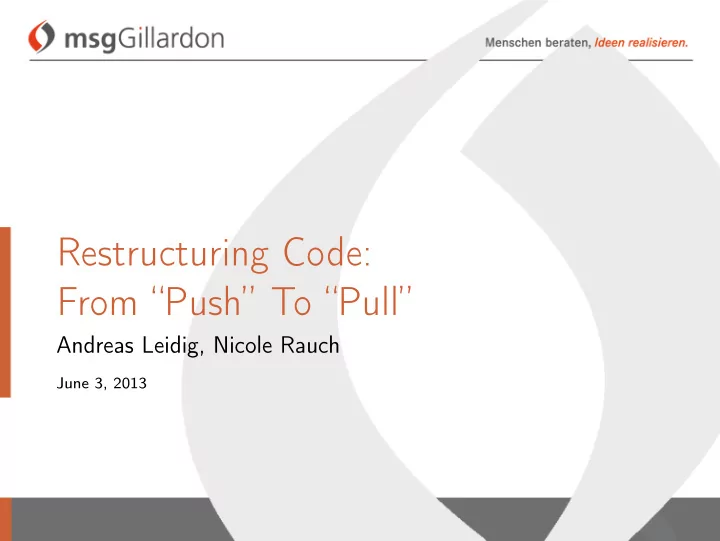

Restructuring Code: From “Push” To “Pull” Andreas Leidig, Nicole Rauch June 3, 2013
Our Starting Point ◮ Business Software ◮ Very poor code quality ◮ Planned changes for a module: ◮ Bugfixing ◮ new features ◮ better tests ⇒ A restructuring was required Andreas Leidig, Nicole Rauch Restructuring Code: From “Push” To “Pull”
The Domain ◮ Financial mathematical software ◮ Calculate for a bank account for each month: ◮ Balance at the last day of the month (ultimo) ◮ Average balance of the month Andreas Leidig, Nicole Rauch Restructuring Code: From “Push” To “Pull”
Problems of the Existing Code Structure ◮ Code writes values into separate data objects („Push“) ◮ Multiple writing operations for one value ◮ Parts of the code access previously written values ◮ Code is driven by the view from the inside: What do I need to do in summary to be able to deliver a set of result values? Andreas Leidig, Nicole Rauch Restructuring Code: From “Push” To “Pull”
Problems of the Existing Code Structure Andreas Leidig, Nicole Rauch Restructuring Code: From “Push” To “Pull”
Our Approach ◮ Assumptions: ◮ The old code is mostly incorrect and incomplete ◮ There is plenty of knowledge regarding the business logic ◮ Decision: ◮ Greenfield reimplementation (with feature-toggle) ◮ Creation of new tests in parallel with the new definition of the business logic ◮ Continuous adaption of the existing tests Andreas Leidig, Nicole Rauch Restructuring Code: From “Push” To “Pull”
Our Experience ◮ Problems: ◮ It was much more complicated and long-winding to specify the business logic than we had expected ◮ Differences compared to the old code are hard to analyze ◮ The test coverage is too low ⇒ We miss relevant cases ◮ Causes: ◮ False assumptions ◮ We mixed restructuring and change ◮ Arrogance („We know things better than our predecessors“) ⇒ Our restructuring approach was much too naïve Andreas Leidig, Nicole Rauch Restructuring Code: From “Push” To “Pull”
How can this be improved? ◮ Gather facts in advance (assumptions are not sufficient) ◮ How much code coverage do we have? ◮ Which business cases are covered? ◮ Is there any specification that matches the code? ◮ If in doubt, the existing code shows the correct behaviour! ◮ Do not change the logic while restructuring! ◮ Explicit approval of the restructuring ◮ It must show identical behaviour (tests, bugs, features) Andreas Leidig, Nicole Rauch Restructuring Code: From “Push” To “Pull”
Goal ◮ Structure: ◮ Code mirrors the business logic ◮ View from the outside, driven by the expected results: ◮ Which values do I need? ◮ How is each value calculated? ◮ Which categories of results exist? Similarities, differences? Andreas Leidig, Nicole Rauch Restructuring Code: From “Push” To “Pull”
Goal Andreas Leidig, Nicole Rauch Restructuring Code: From “Push” To “Pull”
Ideal Approach ◮ Feature-toggle to compare the old and the new version ◮ Identification or creation of a minimal entry point to the restructured area ◮ The API of this entry point must remain unchanged ◮ Important aspects of the restructuring: ◮ Driven by business logic ◮ Purely structural ◮ Technical goal: ◮ Separation of Concerns ◮ On-demand-calculation of all values („Pull“) ◮ Value caching via lazy initialization Andreas Leidig, Nicole Rauch Restructuring Code: From “Push” To “Pull”
Workshop Workshop Andreas Leidig, Nicole Rauch Restructuring Code: From “Push” To “Pull”
Balance Andreas Leidig, Nicole Rauch Restructuring Code: From “Push” To “Pull”
Initial Average Andreas Leidig, Nicole Rauch Restructuring Code: From “Push” To “Pull”
Final Average Andreas Leidig, Nicole Rauch Restructuring Code: From “Push” To “Pull”
Thank you! Code & slides at GitHub: https://github.com/NicoleRauch/RefactoringLegacyCode Andreas Leidig E-Mail andreas.leidig@msg-gillardon.de Twitter @leiderleider Nicole Rauch E-Mail nicole.rauch@msg-gillardon.de Twitter @NicoleRauch Andreas Leidig, Nicole Rauch Restructuring Code: From “Push” To “Pull”
Recommend
More recommend